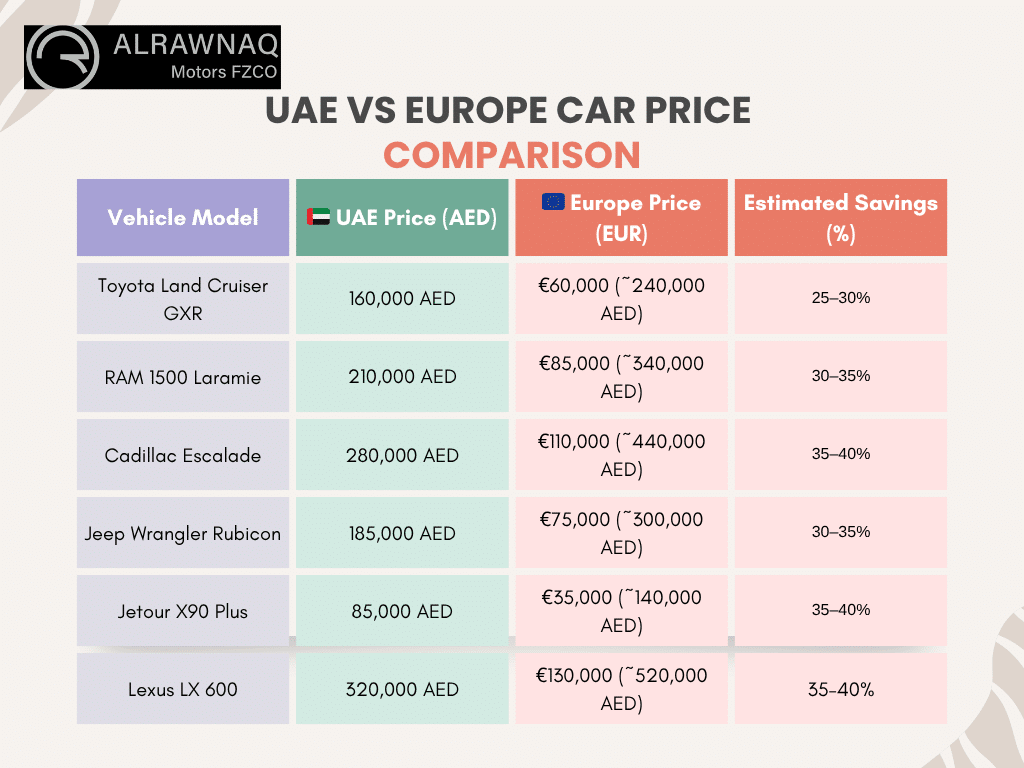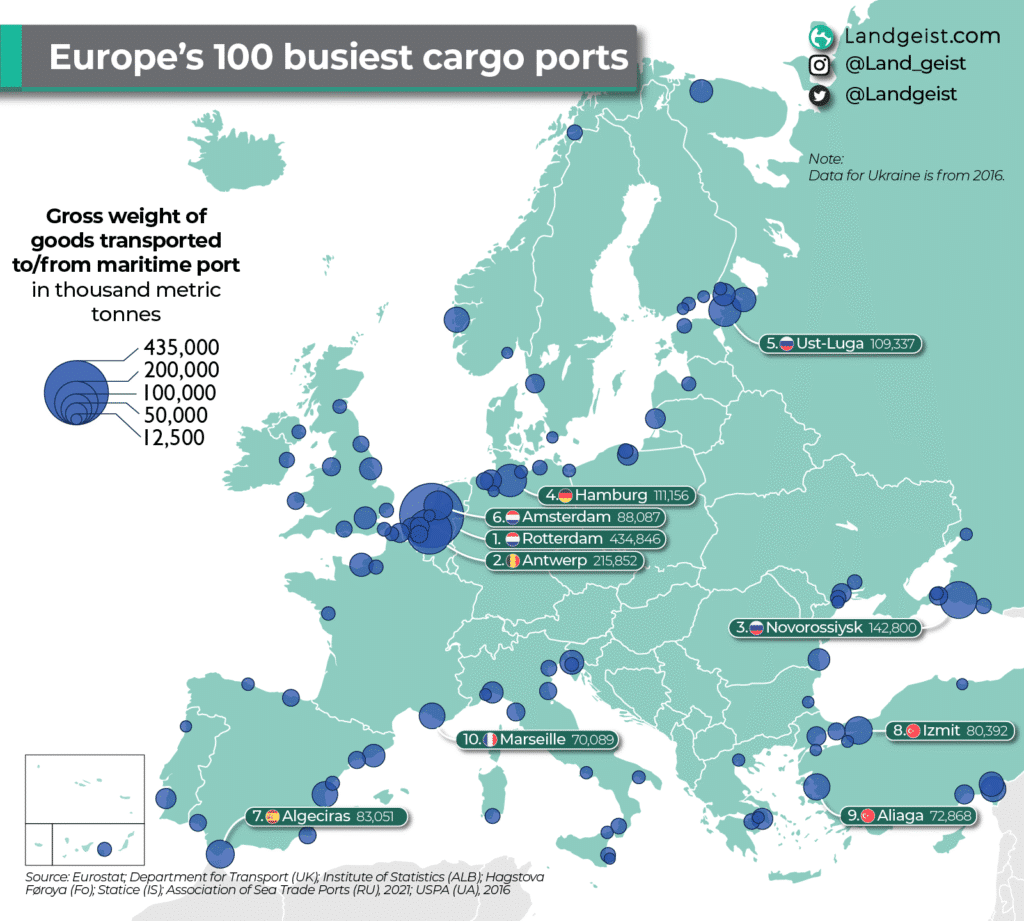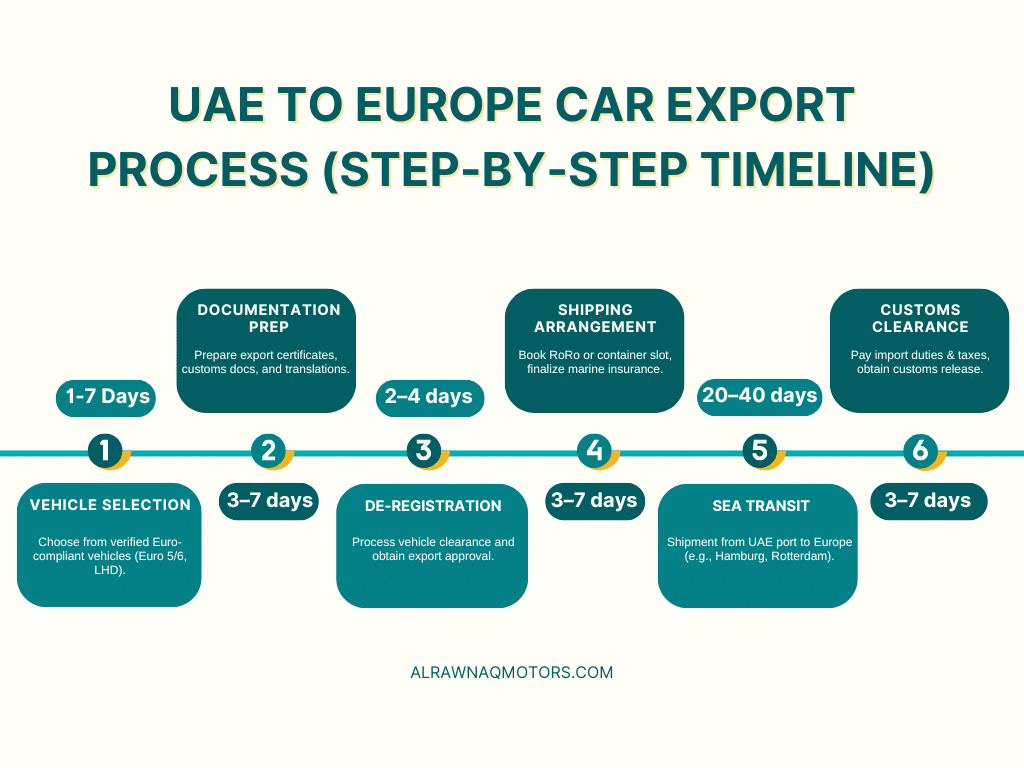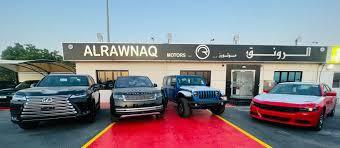Considering buying a car from the UAE and shipping it to Europe? Smart move. The UAE’s tax-free market lets European buyers save 20–40% on quality vehicles compared to local prices. From luxury SUVs to family cars, thousands of Europeans import from Dubai each year, benefiting from great prices and vast options.
However, exporting a car from the UAE to Europe requires understanding import rules, customs clearance, and shipping steps. This guide explains the entire process so you can navigate it confidently and maximize your savings.
Why European Buyers Choose UAE for Car Exports

The UAE has become Europe’s top source for vehicle imports — and for good reason. As a tax-free zone with no VAT on car purchases, buyers save 15–25% upfront, even before factoring in Dubai’s competitive market prices.
UAE dealers offer vast inventories, from German luxury brands like Mercedes-Benz and BMW to reliable Japanese SUVs like the Toyota Land Cruiser. Most cars are new, well-maintained GCC-spec models with full service histories and low mileage. Plus, the UAE’s mild climate helps preserve vehicles better than Europe’s harsh winters and road salt exposure.
Key advantages of UAE car exports:
- Tax-free purchasing saves 15-25% immediately
- Extensive selection of European, Japanese, and American brands
- Well-maintained vehicles with documented service history
- Strategic location with efficient shipping to European ports
- Competitive pricing due to high market turnover
The UAE’s strategic location adds another advantage. Its world-class ports, especially Jebel Ali, offer efficient shipping routes to Europe. Whether importing to Germany, the UK, France, or Spain, strong maritime links ensure reliable transit times and competitive freight rates.
Understanding European Import Requirements

Before shipping a vehicle from Dubai to Europe, it’s vital to understand destination-specific import regulations. While EU countries share general standards, each has unique requirements that affect the process. All European nations require compliance with Euro 5 or Euro 6 emission standards, depending on the car’s age and destination. Left-hand drive is mandatory across most of Europe, except in the UK, where both configurations are allowed.
General European requirements include:
- Certificate of Conformity proving EU safety standards compliance
- Emission certificate meeting Euro 5 or Euro 6 standards
- Left-hand drive configuration (mandatory in most EU countries)
- Vehicle age typically under 10 years old
- Technical inspection upon arrival
Germany requires TÜV inspection within four weeks and may need individual approval for non-EU cars, with 10% duty + 19% VAT.
The UK, post-Brexit, mandates an IVA test, charging 10% duty + 20% VAT under new customs rules.
France needs a Certificate of Conformity and inspection within a month, applying 10% duty + 20% VAT.
Spain requires homologation certificates and ITV inspection, with registration tax based on CO₂ emissions (0–14.75%), plus 10% duty + 21% VAT.
The Netherlands adds a BPM tax tied to CO₂ output—often high for large-emission vehicles—making hybrid and electric cars more cost-effective options.
Understanding these rules upfront helps buyers choose suitable vehicles and budget accurately for total landed costs.
Step-by-Step Export Process from UAE to Europe

Exporting a car from the UAE to Europe takes about 6–10 weeks from purchase to port arrival. Success relies on accurate documentation, the right shipping method, and experienced export agents familiar with both UAE and EU regulations.
Start by choosing a vehicle compliant with your destination’s rules—left-hand drive, proper age, and matching emission standards. Popular exports include Range Rover Sport, Porsche Cayenne, Toyota Land Cruiser, and European models like BMW X5 and Mercedes GLE, all known for strong resale value. Always confirm a clean title, full service history, and no outstanding loans or accident records.
Essential UAE export documents required:
- Original vehicle ownership certificate (Mulkiya)
- Export certificate from Roads and Transport Authority
- Original purchase invoice showing vehicle value
- Passport and Emirates ID copies
- Bill of Lading from shipping company
- Marine cargo insurance certificate
- Certificate of Origin
- Customs declaration forms
After collecting the required documents, the vehicle must be de-registered with the RTA before export. Visit an RTA customer center with your Mulkiya and passport, complete a vehicle inspection to confirm chassis and engine numbers, and clear any bank loans with an NOC if needed. You’ll receive an export certificate (valid 30 days) and temporary export plates. The process takes about 2–4 hours and costs AED 150–300, depending on the emirate.
Next, prepare the vehicle for customs. Conduct a full mechanical inspection of the engine, brakes, transmission, and electronics. Some European destinations require rear fog lights, headlight adjustments, and metric speedometer markings. Clean the car thoroughly—dirty vehicles may be denied entry due to contamination risks.
Shipping Methods: RoRo vs Container
There are two main shipping methods from the UAE to Europe, each suited to different budgets, vehicle types, and timelines.
Roll-on/Roll-off (RoRo) is the most affordable option, costing AED 3,500–6,500 to major ports like Hamburg, Rotterdam, or Barcelona. Cars are driven onto specialized vessels and secured among other vehicles. It’s ideal for standard cars in good condition, offering frequent sailings and 20–35 day transit times. However, RoRo doesn’t protect vehicles from weather or sea salt, prohibits personal items inside, and provides limited insurance coverage.
RoRo shipping characteristics:
- Most cost-effective method (AED 3,500-6,500)
- Transit time: 20-35 days to Europe
- Suitable for running vehicles only
- No personal items allowed inside vehicle
- Exposed to weather during transit
Container shipping offers maximum protection but at a higher cost—AED 8,000–18,000, depending on 20ft or 40ft container size. Vehicles are sealed inside containers, fully protected from weather and handling damage, making this ideal for luxury, classic, or multiple vehicles. You can include personal items or spare parts within limits, and insurance coverage is more comprehensive. Transit takes 25–40 days to major European ports, making it worth the extra cost for high-value vehicles.
Main UAE departure points include Jebel Ali Port (Dubai’s primary export hub), Port Rashid, and Khalifa Port in Abu Dhabi. Common European destinations are Hamburg, Rotterdam, Antwerp, Barcelona, and Southampton/Felixstowe for the UK.
Complete Cost Breakdown
Understanding the full cost breakdown helps you budget accurately and avoid surprises at customs clearance. Many buyers overlook fees beyond purchase and shipping, leading to unexpected expenses.
For a vehicle worth AED 100,000 exported to Germany, UAE-side costs include:
- Vehicle inspection: AED 200–500
- RTA de-registration & export certificate: AED 150–300
- Export documentation: AED 500–1,000
- Shipping: RoRo ~AED 5,000 or container AED 8,000–12,000 (20ft)
- Marine insurance: 1.5–3% of value (AED 1,500–3,000)
- European port handling: AED 800–1,500
This ensures a clear financial picture and accurate comparison with local European prices.
Estimated costs for AED 100,000 vehicle to Germany:
- Vehicle purchase: AED 100,000
- UAE processing & documentation: AED 1,500
- RoRo shipping: AED 5,000
- Marine insurance: AED 2,000
- Import duty (10%): AED 10,000
- VAT (19%): AED 20,900
- Registration & inspection: AED 3,000
- Total investment: AED 142,400
- Same vehicle in Germany: AED 180,000-200,000
- Your savings: AED 37,600-57,600 (21-29%)
European import costs form the largest additional expense. Import duty averages 10% of the vehicle’s declared value, while VAT varies by country—Germany 19%, UK 20%, France 20%, Spain 21%, Italy 22%, and Netherlands 21%. Some nations also charge registration taxes based on CO₂ emissions, especially Spain and the Netherlands.
Other expenses include technical inspection (AED 400–1,100), customs broker fees (AED 800–2,200), compliance modifications (AED 500–2,000), and registration plates (AED 150–400).
Even with these costs, total landed prices remain 20–30% lower than buying locally. For instance, a Range Rover costing AED 250,000 in the UAE might total AED 350,000–400,000 in Europe—still saving AED 50,000–100,000, especially attractive for luxury vehicles.
Customs Clearance and European Registration
Once your vehicle reaches the European port, customs clearance must be completed before registration or legal driving. The process usually takes 3–7 business days if all documents are ready. Your shipping agent alerts you 48–72 hours before arrival to prepare payments and paperwork for duties and taxes.
Clearance starts with submitting an import declaration—online or in person—to customs. Required documents include the Bill of Lading, purchase invoice, proof of ownership, insurance, and any certificates of conformity or origin. Customs may perform a physical inspection to verify the VIN, confirm no undeclared modifications, and ensure compliance with import standards. Inspections may be random or mandatory, depending on the country and vehicle type.
Key customs clearance requirements:
- Import declaration form with all vehicle details
- Payment of import duty (typically 10% of value)
- VAT payment (19-25% depending on country)
- Registration tax where applicable
- Customs processing fees
- Physical vehicle inspection if required
After paying duties and taxes and receiving customs clearance, you can collect your vehicle from the port—but it must be registered before driving legally. Each European country has its own process, typically requiring a technical inspection within 1–4 weeks of arrival. Examples include Germany’s TÜV, UK’s MOT, France’s contrôle technique, Spain’s ITV, and Italy’s revisione, all confirming roadworthiness and emissions compliance.
Some cars need modifications to pass—such as headlight adjustments, rear fog light installation, kilometer-marked speedometers, or warning triangle storage. These upgrades cost about AED 500–2,000 at local workshops. After passing inspection, you complete registration paperwork, pay fees, and receive license plates. The full post-arrival process generally takes 2–4 weeks.
Common Mistakes to Avoid
Many first-time importers face costly issues that proper planning could prevent. Learning from others helps ensure a smooth export process.
The biggest mistake is buying a vehicle that doesn’t meet destination requirements—for example, choosing a right-hand drive car for continental Europe or an older model that fails emission standards. Always confirm your country’s rules on age limits, emissions, drive type, and technical specs before purchase.
Another common error is underestimating total costs by focusing only on the purchase and shipping, forgetting that duties, VAT, registration, and modifications can add 30–40% to the final price.
Critical mistakes that cause expensive delays:
- Buying vehicles that don’t meet destination country specs
- Missing or incomplete documentation causing customs delays
- Underinsuring vehicles during shipping transit
- Under-declaring vehicle value to reduce duties (illegal and risks seizure)
- Skipping pre-export mechanical inspection
- Not budgeting for required modifications
Documentation issues often cause costly delays—missing even one certificate can leave your vehicle stuck at port with EUR 50–100 daily storage fees. Always work with experienced exporters who understand UAE and EU documentation rules. Ensure all papers are complete, notarized if needed, and translated into the destination language. Keep multiple certified copies and send originals via express courier, separate from the vehicle.
Insurance errors can be disastrous. Some buyers skip full coverage to save AED 200–300, only to face total loss from loading damage, collisions, or maritime incidents. Always choose comprehensive “All Risk” marine insurance covering loss, theft, weather, and handling damage—a small premium that protects a high-value investment.
Why Choose Al Rawnaq Motors for Europe Export

Since 2008, Al Rawnaq Motors has exported thousands of vehicles from the UAE to Europe, earning a reputation for transparency, reliability, and full-service support. We know that international car shipping is a major investment, often stressful due to varying regulations across countries.
Our Europe export service manages everything—from vehicle selection to delivery at your destination port. We offer a large inventory of Europe-ready, left-hand drive vehicles meeting Euro 5 or Euro 6 standards, all with clean titles and complete service histories. Our pre-export inspection detects potential issues early, and we handle modifications like rear fog lights and headlight adjustments to ensure your car passes European technical inspection on the first attempt.
What sets Al Rawnaq Motors apart:
- 15+ years specializing in European exports
- Pre-verified vehicles meeting EU regulations
- Complete documentation handling and customs support
- Competitive shipping rates to all major European ports
- Real-time tracking and regular status updates
- Customs broker connections across Europe
- Transparent pricing with no hidden fees
Documentation preparation is one of our core strengths. Our expert team understands each European country’s requirements, providing complete documentation packages—including export certificates, customs declarations, conformity assistance, and translations where needed. We coordinate with customs brokers abroad for smooth clearance and even guide you through local registration after arrival.
We’ve secured preferential rates with major European shipping lines, offering competitive pricing for both RoRo and container shipping. Partnering with reputable carriers, we ensure safe handling, comprehensive insurance, and real-time tracking with timely updates.Most importantly, our transparent pricing includes a full cost breakdown upfront—no hidden fees or surprise charges—so you can plan your budget accurately and see your exact savings compared to European market prices.
